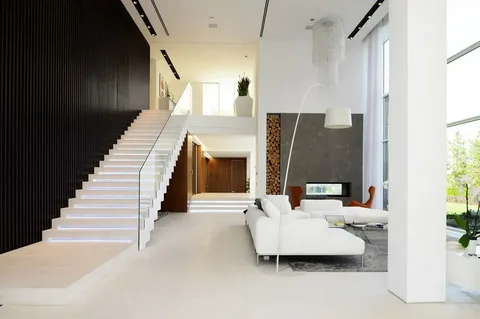Welcome readers to your complete guide to interior design, where you will help them transform their space into a stylish and functional home. You understand the importance of interior design in creating a space that reflects their personality and meets their needs.
With this guide, readers will gain a deeper understanding of interior design basics, find their personal style, learn practical tips and tricks, and even consider the benefits of working with an interior designer.
Understanding Interior Design Basics
- What is Interior Design?
Interior design is the art and science of enhancing the interior of a space to create a more aesthetically pleasing and functional environment. It goes beyond just choosing furniture and paint colors; it involves careful planning, attention to detail, and a deep understanding of how people interact with their surroundings.
Hiring Best Interior Designer in Rajkot can be incredibly beneficial as they have the expertise and experience to bring your vision to life while considering factors like functionality, budget, and style.
-
Elements of Interior Design
- Color Palette
Colors have a profound impact on our mood and the overall atmosphere of a room. When selecting a color scheme, it’s important to consider personal preferences, the purpose of the space, and the desired mood.
Warm colors like red and orange can create a cozy and inviting atmosphere, while cool colors like blue and green promote relaxation and tranquility. Mixing and matching colors can add depth and visual interest to a room. Experiment with different color combinations and consider using color psychology as a guide.\
- Furniture Placement
The way furniture is arranged plays a crucial role in optimizing space and flow in a room. Start by analyzing the room layout and identifying focal points such as windows, fireplaces, or architectural features.
Arrange furniture in a way that allows for easy movement and conversation. Consider the scale and proportion of the furniture, ensuring it suits the size of the room. Experiment with different furniture layouts to find the one that works best for your space.
- Lighting
Lighting is an essential element in interior design, as it can dramatically impact the ambiance and functionality of a room. Natural light is ideal, as it provides a sense of openness and connection to the outdoors. However, it’s important to supplement natural light with artificial lighting options to create a well-lit space.
Overhead lighting, such as chandeliers or pendant lights, can provide general illumination, while accent lighting can highlight specific areas or objects. Consider using dimmers to adjust the lighting levels according to the desired mood.
Finding Your Style
- Exploring Different Interior Design Styles
- Modern/Contemporary
The modern or contemporary style is characterized by clean lines, minimalism, and a focus on functionality. Neutral color palettes and materials like glass, metal, and concrete are often used. Furniture pieces are sleek and simple, with an emphasis on comfort. Showcase your personal style through artwork and accessories.
- Traditional
Traditional design is all about elegance and classic charm. It embraces ornate details, rich textures, and warm color palettes. Furniture pieces often have intricate carvings and are made from high-quality materials like wood. Traditional interiors exude a sense of timelessness and sophistication.
- Minimalist/Scandinavian
Minimalist design aims to create clean, clutter-free spaces that promote tranquility and simplicity. Scandinavian design, originating from Nordic countries, emphasizes functionality and natural materials. Neutral color schemes, light and airy spaces, and minimalistic furniture are common features. Incorporate elements of nature through plants and organic textures.

- Assessing Personal Style Preferences
- Questionnaire or Quiz
To help readers identify their preferred style, create a simple questionnaire or quiz that asks about their color preferences, furniture preferences, and desired mood for their space. Use this information to guide them towards their ideal interior design style.
- Mood Boards
Encourage readers to create mood boards using online tools or magazine cutouts. Mood boards are visual representations of desired aesthetics and can help clarify style preferences. They serve as a reference point when making design decisions and can ensure cohesion throughout the space.
Practical Interior Design Tips and Tricks
- Maximizing Small Spaces
Small spaces require careful planning to maximize functionality and create the illusion of a larger space. Choose multi-functional furniture pieces that provide storage solutions, such as ottomans with hidden compartments or beds with built-in drawers. Utilize vertical space by installing shelves or hanging artwork. Opt for light-colored walls and mirrors to create a sense of openness.
- Incorporating Personal Touches
Your home should reflect your personality and tell your story. Infuse your personal touch by displaying cherished items, incorporating hobbies, or showcasing artwork. Create a gallery wall with your favorite photos or create a display shelf for your collection of books or vintage items. Incorporating personal touches adds warmth and personality to your space.
- Budget-Friendly Design Ideas
Interior design doesn’t have to be expensive. There are plenty of budget-friendly options to achieve a stylish look. Explore affordable decor stores, thrift shops, or online marketplaces for unique and affordable pieces. Consider DIY projects like painting furniture or creating your own artwork. Upcycling and repurposing old items can also add a creative and personalized touch to your space.
Working with an Interior Designer
While interior design can be a rewarding DIY project, working with an interior designer can take your space to the next level. They have the knowledge, expertise, and industry connections to create a space that perfectly suits your needs and reflects your personal style. When hiring an interior designer, consider their portfolio, experience, and communication style. Clearly communicate your preferences and goals to ensure a smooth collaboration.
Conclusion:
In this complete guide to interior design, we’ve covered the basics of interior design, explored different design styles, shared practical tips and tricks, and even considered the benefits of working with best interior designer in Rajkot.
By understanding the elements of interior design, finding your personal style, and implementing practical design ideas, you can transform your space into a stylish and functional home. Embark on your interior design journey with confidence and creativity, and remember to have fun along the way. Seek further inspiration through related articles or consider contacting a local interior designer for personalized advice. Happy designing!








